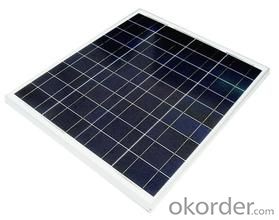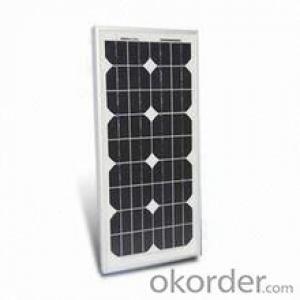CNBM Poly 220W Solar Panel with TUV UL CE Certificate For Residential
- Loading Port:
- Shanghai
- Payment Terms:
- TT OR LC
- Min Order Qty:
- 100 watt
- Supply Capability:
- 1000 watt/month
OKorder Service Pledge
OKorder Financial Service
You Might Also Like
Item specifice
CNBM Poly 220W Solar Panel with TUV UL CE Certificate For Residential
Introduction
Electrical connections are made in series to achieve a desired output voltage and/or in parallel to provide a desired current capability. The conducting wires that take the current off the modules may contain silver, copper or other non-magnetic conductive [transition metals]. The cells must be connected electrically to one another and to the rest of the system. Externally, popular terrestrial usage photovoltaic modules use MC3 (older) or MC4 connectors to facilitate easy weatherproof connections to the rest of the system.
Each module is rated by its DC output power under standard test conditions, and typically ranges from 100 to 365 watts. The efficiency of a module determines the area of a module given the same rated output – an 8% efficient 230 watt module will have twice the area of a 16% efficient 230 watt module. There are a few solar panels available that are exceeding 19% efficiency. A single solar module can produce only a limited amount of power; most installations contain multiple modules. A photovoltaic system typically includes a panel or an array of solar modules, a solar inverter, and sometimes a battery and/or solar tracker and interconnection wiring.
Micro-inverted solar panels are wired in parallel which produces more output than normal panels which are wired in series with the output of the series determined by the lowest performing panel (this is known as the "Christmas light effect"). Micro-inverters work independently so each panel contributes its maximum possible output given the available sunlight.[6
A solar cell, or photovoltaic cell (in very early days also termed "solar battery"[1]– a denotation which nowadays has a totally different meaning, see here), is an electrical device that converts the energy of light directly into electricity by thephotovoltaic effect, which is a physical and chemical phenomenon.[2] It is a form of photoelectric cell, defined as a device whose electrical characteristics, such as current, voltage, or resistance, vary when exposed to light. Solar cells are the building blocks of photovoltaic modules, otherwise known as solar panels.
Solar cells are described as being photovoltaic irrespective of whether the source issunlight or an artificial light. They are used as a photodetector (for example infrared detectors), detecting light or other electromagnetic radiation near the visible range, or measuring light intensity.

Suggested application
Home lighting business lighting,
Garden lighting, pavement lighting
Farmer household lighting
Decorative water pump
Traffic signal lighting
Industry area
Business area
Solar Power Plant
Product feature
Modules are made of Monocrystalline or Polycrystalline Silicon cell.
Materials and color of the solar panel frame: Clear anodized aluminum alloy type 6063T5 Universal frame; Silver-white color;
The output connection gathers the coupling: Selects conforms to the IEC-612615; 2005, class II, IEC61730 international standard; Airtight waterproofing binding clamp;
Module seal structure: The surface is thick, the high diaphanous rate armored glass with solar cell board special-purpose 3.2mm becomes after the high temperature lamination craft. The back selects has waterproof and anti- aged performance fine TPT materials. The entire block battery board has, the waterproofing, the anti- aging airtight and so on the fine performance;
Power tolerance: +/-3%
Packaging
International standard cartons (according to the requirements of customers)
- Q:How do solar panels affect the property's energy management system?
- Solar panels can significantly impact a property's energy management system by generating clean and renewable electricity. They reduce the reliance on traditional power sources, thereby lowering energy costs. Solar panels also allow for greater control over energy production and consumption, enabling property owners to better manage their energy usage and potentially even sell excess electricity back to the grid.
- Q:Can solar panels power an entire home?
- Yes, solar panels can power an entire home. By harnessing the energy from the sun, solar panels can generate electricity to meet the energy needs of a household. The number of solar panels required depends on factors such as the home's energy consumption, sun exposure, and panel efficiency. With proper installation and sizing, solar panels can effectively provide power for all the electrical needs of a home, including lighting, appliances, and heating/cooling systems.
- Q:I'm going to pitch an idead to my school about switching to Solar Energy. What are positive and negative effects of the solar panels?Also what is the cost for installing them into a highschool?How much would the electricity bill decline afterwards?
- Solar panels can convert sunlight into electricity which can be used in daily life,solar panels utilize sunrays,it doesn't discharge any polluted gas,it is environment friendly,it is also cost effective,you can make money by sell the surplus electricity to your country, On question is that solar panles have to be use in where sun is abundent.
- Q:If a solar panel has a power rate of 80 Watts and efficiency of lets say 30%. Does that mean the maximum power this solar panel can generate is (30/00)*80=54 Watts or its just 80 Watts?
- If it says STC or Standard Test Conditions on the nameplate or documentation, then that means 80 watts under bright sun at an unrealistically cool temperature. It is rare to see that power in real life, except when the perfect storm of conditions come together. There is also a PTC rating for some panels, which is more realistic. If the panel does not say STC or PTC, the manufacturer is free to make up whatever test they feel like, which generally leads to ridiculously overstated power. As for efficiency, for residential panels, that's generally only of academic interest. A 80-watt panel is 80 watts, regardless of the efficiency. A more efficient panel will take up slightly less space, but most people are more interested in the total price, since roof space is generally not an issue.
- Q:Is there a small solar panel system that I can put in my bedroom window and charge my phone and run an alarm clock off of? Or one I can run a microwave off of?
- You can cosider this product Flexible Personal Solar Panel. I think it will be helpful. Product Review Take the lightweight, easy-to-pack Brunton Solaris 6 / 2 Solar Panels on your next expedition to the Himalayas or down that nearby trail or dirt road. Brunton used CIGS, the most efficient thin-film solar technology available, to create the Solaris. Choose either the Solaris six-watt or 2-watt panel—both of them fold up to the size of a CD wallet and work, even in overcast conditions, to charge your cell phone, digital camera, camcorder, iPod, and other small electronics. A built-in reversing diode prevents the solar panel from discharging your batteries when the sun disappears for the night. Brunton's Solaris 2-watt panel can even charge your satellite phone or trickle charge your laptop.
- Q:Mono-crystalline or poly-crystalline solar panel?
- All solar photovoltaics drop in efficiencies with higher temperatures but it isn't the 45+ C you have to worry about but rather the heat from the sunlight striking the panels. There are hybrid systems which passes water in pipes attached to the back of the solar panels to cool the panels and preheat the water for solar thermal collectors. The difference between mono-crystalline and poly-crystalline are that mono-crystalline are more efficient and more costly to make.
- Q:Its cloudy out and i have a solar panel that has 3, .5 volt cells But how do i charge it without sun any other ways?
- For the best answers, search on this site https://shorturl.im/awXJ0 The charge controller will protect the battery. You might want to think about getting a fuse.
- Q:Are there any free classes to learn about solar energy and building a solar panel
- Why don't you just call a solar energy company and ask them anything you need to know, or check out websites- they usually have page with faqs or info. The company I used has lots of info on their website and they were very helpful.
- Q:Do solar panels require building permits?
- Yes, solar panels typically require building permits. The requirements for obtaining a building permit may vary based on location and jurisdiction. It is essential to check local regulations and obtain the necessary permits before installing solar panels.
- Q:What is the biggest solar panel you can buy?How much energy can it produce in kwh?Thanks :)
- come to tn
1. Manufacturer Overview |
|
|---|---|
| Location | |
| Year Established | |
| Annual Output Value | |
| Main Markets | |
| Company Certifications | |
2. Manufacturer Certificates |
|
|---|---|
| a) Certification Name | |
| Range | |
| Reference | |
| Validity Period | |
3. Manufacturer Capability |
|
|---|---|
| a)Trade Capacity | |
| Nearest Port | |
| Export Percentage | |
| No.of Employees in Trade Department | |
| Language Spoken: | |
| b)Factory Information | |
| Factory Size: | |
| No. of Production Lines | |
| Contract Manufacturing | |
| Product Price Range | |
Send your message to us
CNBM Poly 220W Solar Panel with TUV UL CE Certificate For Residential
- Loading Port:
- Shanghai
- Payment Terms:
- TT OR LC
- Min Order Qty:
- 100 watt
- Supply Capability:
- 1000 watt/month
OKorder Service Pledge
OKorder Financial Service
Similar products
New products
Hot products
Related keywords





























